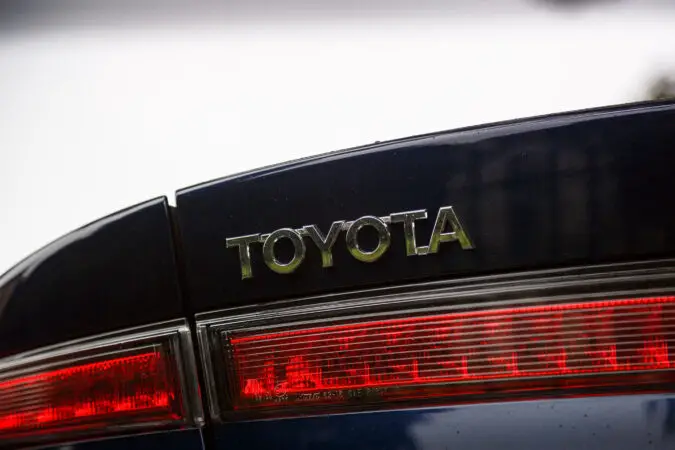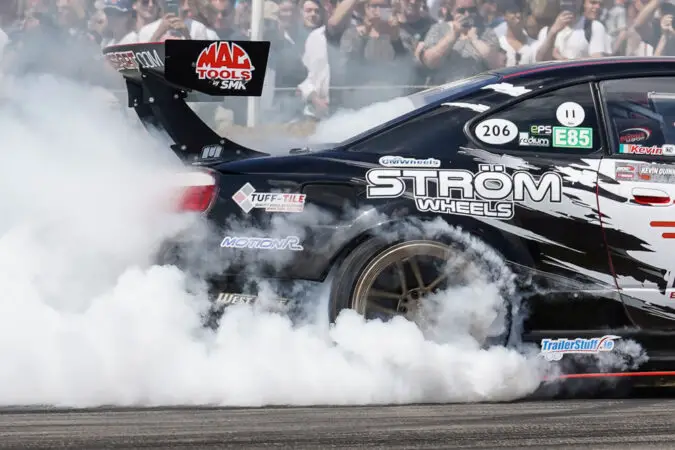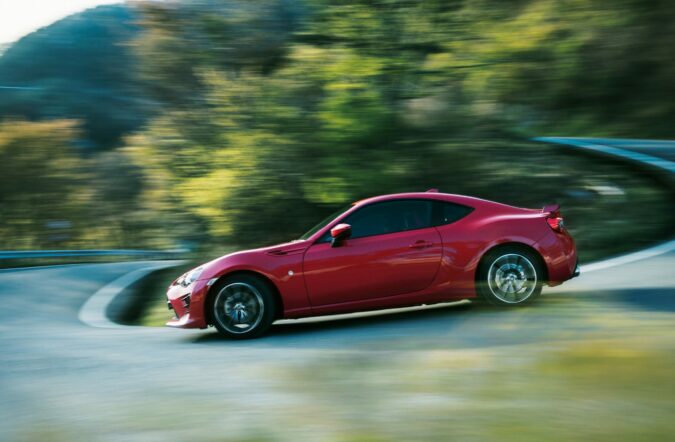You do not get to see every day that an automobile is recognized by its production codename instead of the model name under which it was marketed in dealerships. The Toyota AE86 is a halo vehicle in the Japanese classic automobile industry. When did you first become a fan of the Toyota Trueno AE86? Do you think you know everything about this beloved classic? Let’s put your knowledge to the test!
The Toyota Trueno AE86 generation is a compact, lightweight coupe or hatchback that Toyota released in 1983 as part of the fifth-generation Toyota Corolla series. For the sake of simplicity, the insider-chassis code “AE86” represents the range’s 1600 cc RWD model.
The Trueno has pop-up headlights and is available in hatchback or coupe body styles. The AE86 was rear-wheel drive and was one of the last rear-drive cars produced at a period when many passenger vehicles were being converted to front-drive.
In 1987, there was also a limited edition released by Toyota. This AE86 model was named “Black Limited” which acted as a send-off model.
The Trueno most likely emerged because, back in 1983, when these vehicles were available new, there was a perplexing scenario in the UK. The AE86 has earned a position in the automotive legion as a result of its renown in racing and popular culture. With such a legendary history, it’s clear to see why they continue to command a premium more than three decades after they initially entered the market.
History Of Naming The Toyota Trueno
The Toyota Sprinter Trueno AE86 generation is a compact, lightweight coupe or hatchback that was released by Toyota in 1983. It was a part of their fifth-generation Toyota Corolla series. In Japan, the AE86 was also called the ‘Hachi-Roku.’ Hachi-Roku is Japanese for ‘eight-six.’ So it is the car number translated in Japan.
Not The First Naming Attempt
This wasn’t the first instance for Toyota to follow this number-translation naming strategy. The AE85 was named ‘Hachi-Go’ in the Japanese market, which translates to ‘eight-five.’ For the sake of simplicity, the insider-chassis code “AE86” represents the range’s 1600 cc RWD model.
The letter “A” symbolizes the engine that arrived with the automobile that belongs to the 4A series. The letter “E” denotes the Corolla. The “8” in the name represents the fifth generation, also known as the E80 series. The letter “6” represents the variety within this generation.
The Spanish word ‘Trueno’ means ‘thunder.’ In Japan, the Sprinter Trueno was only available through Toyota Japan dealerships known as Toyota Vista Store.
The AE86’s wide variety of versions laden with JDM components contributed significantly to its attractiveness, letting one immerse themselves in depths of obscure knowledge. Toyota created two distinct models for two of its Japanese dealer networks. While technically identical, the Corolla Levin sported fixed headlights, and the Sprinter Trueno sported characteristic 1980s pop-ups. Only the fixed-headlight variants were sold in Europe, although they were still referred to as Corollas.
The Popularity Of The Toyota AE86
What makes a car popular? Its excellent service, exquisite design, dependability, and so on. Sometimes, cars can be famous thanks to some external factors as well. For instance, being referenced in pop culture can make a car gain tremendous popularity. This is the case for the Toyota Trueno.
‘Initial D’ was a very popular Japanese manga series. The lead character, Takumi Fujiwara, is a street racer. Which car did he drive? A Toyota Trueno AE86. The manga series was later developed into several animated and live-action projects. In all of those projects, the AE86 never failed to make an appearance. The car has also appeared in other movies, series, and video games over the years which just made it all the more popular.
View this post on Instagram
The AE86 was influenced by Japanese racing driver Keiichi Tsuchiya’s automobile (if you too want to learn how to become a race car driver). Tsuchiya was a muse as well as an overseer for Initial D. Many of the changes on the Initial D car, including the TRD carbon-fiber bonnet and Fujitsubo exhaust, were identical to Tsuchiya’s actual vehicle.
Aside from Initial D, the AE86 made hit the big screens in one of the biggest movie franchises in the world, the Fast and Furious series. The Toyota Corolla Levin AE86 is instantly recognizable in the blockbuster Fast and Furious: Tokyo Drift.
There is one person responsible for hoisting the AE86 into the popular consciousness. His name is Keiichi Tsuchiya, and he is also known as the “Drift King.” He was a rogue racer. Keiichi saved money for his Toyota Corolla Trueno in the mid-1980s by working numerous jobs. He worked throughout the day and improved his driving abilities at night while holding the keys. His preferred stomping grounds are Japan’s highland highways.
The “Drift King” Keiichi Tsuchiya
Tsuchiya did go racing and subsequently dialed back his excitement to enjoy an excellent career; he almost missed out on the first step at Le Mans in 1999, but his ability for drifting will be recognized as his sporting legacy. As the sport’s appeal increased, so did admiration for the Toyota Trueno AE86.
When he grew tired of ruling the race tracks, Tsuchiya swerved his AE86 into curves for the people’s pleasure. He got so adept that he began doing it on Japan’s famous mountain roads and made Pluspy, a wacky yet intriguing video that quickly went viral.
The on-road driving shenanigans seen in this video are said to have lost him his domestic racing license following a run-in with Japanese officials. Despite having his newbie license canceled due to his stunning but illegal exploits, he had introduced drifting to legitimate racing, giving the sport respectability. Keiichi was named the ‘Drift King’ after this stunt.
More than that, he charmed a generation, immortalized in Initial D, a manga series in which the hero drives an AE86 across the highlands delivering tofu. Given Tsuchiya’s fame for his drift bible series, there’s likely no better guy for the task when it comes to knowing the specifics of automobile control.
Keiichi immediately developed an underground following as an adventurous street racer pulling stunts that no one had seen before. After he became a professional racer, he brought his oversteer slip onto the track, adding to the thrill for racing fans.
Is The Toyota Trueno A Good Drift Car?
Even with its clunky form, the Toyota AE86 was expertly engineered. When you rev the engine to 7600rpm, the transmission remains highly accurate, with the stick shift gliding into each gear effortlessly and without any effort. At the red line, the steering becomes a little heavier, but it still handles the car expertly.
It is the heftiness of the steering that lends the car so nicely to drifting. The turning with such difficult steering almost drives the driver to overcompensate and begin a drift. Many AE86 owners also say that the car has a spinning rear wheel that can impede speedy departures.
View this post on Instagram
Overall, if you ever get the pleasure of driving and drifting an AE86, you’ll discover a car that is responsive, nimble, smooth, and easy to handle. The Toyota AE86 is treasured by drifters and enthusiasts for its near-perfection as a drifting tool, thanks to a traditional RWD balance and a basic design that is a trademark of Japanese performance.
The Classic Design Of Toyota Trueno
Toyota AE was released in two designs, each with a distinct set of features and a few aesthetic alterations to the chassis. The original variant, known as Levin (which is Spanish for thunder), is recognizable by its combination of headlights.
As for the second version, Trueno is most identified with AE because of its distinctive, retractable headlamps. Leather seats are available on some models. It’s a positive thing if you come across a vehicle with a respectable interior. The driver’s cab is spacious and pleasant for a driver and a passenger.
1. Great Outlook
The car became available in a variety of body styles (including a three-door hatchback), but the coupe was by far the most attractive. The automobile has a well-balanced appearance. The design is characteristic of the 1980s, with chopped forms, square lighting, and few exotics.
Its bumpers were not painted straight out of production, but on the Toyota AE86, a trendy body kit and lip were commonly installed, making it all the more aerodynamic. Wheel arches let you use any wheels you choose. The car looks great on traditional disks.
The inside of the Toyota Trueno AE86 has air conditioning, a radio, and one cup holder in the middle of the dashboard on some models. The storage room is limited. However, each door has a jacket pocket that will come in handy. Ask any AE86 admirer now what makes the car so unique, and they won’t simply say the layout. Admittedly, the chassis was essentially carried over from the prior years, when all body types were RWD.
The Toyota Trueno model is quite often featured in drifting events, as is the so-called controlled slip driving approach. This is because of the rear-wheel-drive system, which provides for greater control of the vehicle when it slips.
2. Under The Hood Of The Toyota Trueno
In the normal configuration, the Trueno featured a maximum power output of 128 HP at 6,600 rpm and torque of 149 Nm at 5,200 pm. But, it was eventually down-rated to 118 HP and 142 Nm in total output.
The engine is keen to rev up to its redline of 7600rpm, and from there, the transmission is accurate and enjoyable to drive. The steering is free of power assistance. The Trueno always had reasonably lax body control, which is why it was such an ideal automobile to understand the essential role of weight transfer in vehicle dynamics, and roll center adjustments are a handy retrofit to alleviate bump steer on lowered models.
3. Transmission
The Toyota AE86 was equipped with a 5-speed manual transmission and subsequently an automatic transmission, and it could accelerate from 0-100 km/h in 8.9 seconds. The 4A-GE engines used for the AW11 and AE86 are fitted with the T-VIS. A little old-school tinkering improves the engine’s performance. So, try to open up the ventilation a bit with a filter, change the manifold with extractors, and install a less restricted exhaust, that’s a good way to begin.
The 1587 cc 4A-C SOHC engine was deployed in American AE86 SR5 cars, which did not have additional LSD and had rear drum brakes. In addition, the SR5 model came with a softer suspension as well as minor design and interior improvements. LSD was available as an option on the AE86. It’s a tough engine that can go around four hundred thousand kilometers if properly maintained. The motor was even featured in the Formula Atlantic open-wheel racing competition in a modified form.
Before moving on to the next section, check out this video!
Toyota Trueno AE86 Vs. GT86
Toyota has an impressive track record in sports cars, with models ranging from the MR2 through the Supra. However, when it unveiled the GT 86, it took inspiration from the Corolla AE86 of the 1980s – a car that has become a cult classic because of its rear-wheel-drive architecture and unadulterated driving experience.
Some believe the GT86, was released in the United States as the Scion FR-S and was shortly relabeled as the Toyota 86. It was a reasonably priced, lightweight vehicle with a proclivity towards oversteer.
1. Interior
While being the smallest petite four-seater sports car on the market, the Toyota GT86 is not claustrophobic in the interior. Toyota, on the other hand, has smartly built the inside to be pleasant, well-equipped, and, most notably, driver-focused.
The contoured cloth seats are set low (it helps to learn how to get stains out of car seats), which is important for keeping a low center of gravity and giving passengers a sporty sensation, and the tiny steering wheel and quick, short-throw gearbox are coated in buckskin leather that’s a pleasure to grasp. LED daylight running lights assist with visibility on the road, while high flash headlights guarantee the driver can see the road well at nighttime.
2. Steering
The rack and pinion steering of the GT86, apart from the AE86, is power-assisted, yet it seems every bit as precise and just about as hefty, reacting promptly to driver input. In regards to steering, the key difference between the two is the respective width of the wheels.
Where the GT86 has a thick-rimmed, small-diameter wheel, the AE86 comes with a big, thin wheel. When it comes to wheels, the standard-fit alloys are tiny 14-inch pieces, but you’ll discover better tire alternatives by upgrading to 15-inch wheels, which fit the arches a little more and also aid with accessibility and cooling if you’re considering a huge brake package.
3. Outlook
The AE86 was neither clunky nor blobby as an ’80s car. Although the pop-up headlights are a little archaic, the overall dimensions are pretty appealing. The GT86, like the other concept vehicles that came before it, is devoid of AE86 components. Moreover, the bulges above the front fenders provide the impression of extra weight on the nose. Finally, the GT86 mixes all of its ancestor’s greatest features, but with a touch of creature luxury and up to 40mpg.
4. Toyota Trueno AE86 And Motorsport
The Toyota AE86 was a top choice for showroom stock, Group A, and Group N racing, particularly rallying and circuit racing, throughout its manufacturing run. Even after manufacturing ceased, several privateer teams kept racing the AE86. The AE86’s rear-drive arrangement, which is not available in most current lightweight coupes, contributes to its enduring popularity in racing.
The 4A-GZE engine was famous in Group A world rally vehicles (1600 cc class). In Group A touring race events, the Trueno AE86 either ruled the lower category when it was eligible or battled it out with cars like the Honda Civics.
View this post on Instagram
Beginning in 1985, the AE86 dominated the Australian Touring Car Championship’s under-2.0-litre class, with a best outright placing of eighth at the 1985 Sandown 500. During 1985 and 1986, Toyota AE86 won titles in major touring car competitions from Europe to Japan and the United Kingdom. The AE86 was popular in Ireland, where rallying is regarded as one of the most popular types of racing because of more flexible organizational requirements than in other nations.
Buying Guide For Toyota Trueno
Whether it is drifters in Japan, rally drivers in Finland, car enthusiasts in Ireland, or racers all around the world, the Toyota Trueno is a beloved vehicle. The devotion spread even to comic book enthusiasts, with the small Toyota’s reputation for giant-killing serving as a prominent premise in the enormously popular Japanese manga Initial D.
You might love the car, but we can bet that you will not be the first of the line to buy one. The reason for this is that not every normal fan can manage the labor, money, and difficulty required to bring this car back to top form. It will be a smoother process if you have a lot of money or if you are a mechanic yourself.
However, no matter when or from where you decide to buy an AE86, make sure to do a thorough inspection before putting down your deposit. Unless the car is in good condition, you can end up paying more for the repairs than the purchasing price.
1. Engine And Transmission
The base 4AGE was a 1.6-liter injected inline-4 with a twin-cam, 16-valve head co-developed with Yamaha that could rev to 7700rpm. It’s a durable engine that can go over three hundred thousand kilometers if properly maintained. Check for oil leaks when seals wear down. It is not a terrible idea to perform a compression test. If the engine has to be rebuilt, the parts are fairly affordable. Look for a vehicle with a factory-installed limited-slip axle.
2. Suspension
Inspect the bushings, ball joints, wheel bearings, and so on. All of them wear out, but they can be simply replaced. The AE86 is equipped with MacPherson struts in the front. And, it has a live rear axle with coil springs in the back. JDM vehicles have four-disc brakes. On standard AE86s, the four discs are minimally stressed due to the low power and small weight. Though, try to find pad and disc deterioration. Calipers might seize as a result of poor usage.
3. Electric Components
Back when it was new, the inside of the Trueno AE86 was more on the affordable side. It’s a positive indicator if you locate a car with a nice interior. Dashboard cracks are prevalent, and the basic seats are readily worn out. Make sure you inspect the dashboard for any faulty wires. The clock frequently faces fractures, although it is readily changed. A few hiccups are acceptable when it comes to the electrical components. But, make sure it will not leave a big dent in your pocket after maintenance.
Toyota AE86 – A Cult Classic Car
- The Toyota AE86, also known as Hachiroku, is a Japanese car that has become a cultural icon since its release almost three decades ago.
- The AE86 has a high residual value, with original and roadworthy models selling for as much as £11,500 in the UK.
- Professional racing driver and “Drift King” Keiichi Tsuchiya is partly responsible for the AE86’s popularity and value due to his involvement in drifting events and videos featuring the car.
- Tsuchiya perfected his drifting skills on Japan’s mountain roads and organized the first legitimate drifting event, D1 Grand Prix, in 1988.
- The AE86 became even more iconic when it was featured as the car of choice for the lead character in the hugely successful Japanese comic book series Initial D, based on Tsuchiya.
- The AE86 has been successful in circuit racing and rallying, contributing to its legendary status.
- Behind the wheel, the AE86 feels sprightly, despite its 1.6-liter four-pot engine with 123bhp, and is an excellent car to learn about the nature of rear-wheel drive.
- The AE86 lacks power assistance for the steering and brakes, but the gearbox is precise and a pleasure to use.
- Compared to the GT86, the AE86 is a more mechanical and classic driving experience, but the GT86 has encapsulated the spirit of the old car while offering more modern amenities.
- The AE86 is a desirable vehicle due to its balance, mechanical simplicity, and classic RWD handling, which have made it attractive to drifters and car enthusiasts alike.
Conclusion
Although the Toyota Trueno AE86 was already a favorite among racers and drivers, it was simply another automobile to the general public. However, this changed in 1998 when Initial D was converted into an anime series. The AE86’s Initial D effectively pushed the AE86 into fame. The Drift King Tsuchiya is also to be thanked for bringing the car into the limelight.
Back in the 80s, the whole Japanese car industry had made a 180-degree turn worthy of a fashion magazine. Rear-wheel drive was eliminated, and front-wheel drive was introduced. This was notably true at Toyota. Vehicles such as the Corona, Celica, and others all evolved into pullers rather than pushers. The Toyota Trueno is a sportier version of the Corolla line.
Beyond everything, the AE86 is a wonderful car for learning about the dynamics of rear-wheel drive. Yet, it has the typical RWD balance and graceful, technical elegance that has made it so appealing to drifters.




